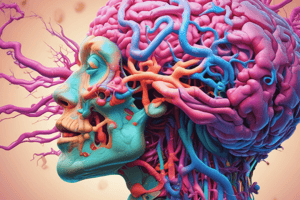Podcast
Questions and Answers
Which one of the following is an accurate definition of diseases and disorders?
Which one of the following is an accurate definition of diseases and disorders?
- Diseases and disorders refer to abnormal or pathological conditions that disrupt the normal functioning of the human body. (correct)
- Diseases and disorders are common ailments that everyone experiences at some point in their lives.
- Diseases and disorders only affect mental health.
- Diseases and disorders are exclusively caused by genetic factors.
Why is understanding diseases and disorders important?
Why is understanding diseases and disorders important?
- Understanding diseases and disorders is not important for individuals' well-being.
- Understanding diseases and disorders is solely for academic purposes.
- Understanding diseases and disorders helps individuals make informed decisions about their well-being and the well-being of others. (correct)
- Understanding diseases and disorders only helps medical professionals.
What is the significance of early detection and treatment of diseases and disorders?
What is the significance of early detection and treatment of diseases and disorders?
- Early detection and treatment are only necessary for communicable diseases.
- Early detection and treatment increase the chances of successful outcomes. (correct)
- Early detection and treatment are irrelevant for non-communicable diseases.
- Early detection and treatment have no impact on the outcome of diseases and disorders.
Which of the following is an example of a communicable disease?
Which of the following is an example of a communicable disease?
Which of the following is a risk factor for non-communicable diseases?
Which of the following is a risk factor for non-communicable diseases?
Which of the following is an example of a chronic respiratory disease?
Which of the following is an example of a chronic respiratory disease?
Which of the following is a way to prevent the spread of communicable diseases?
Which of the following is a way to prevent the spread of communicable diseases?
Which of the following is a characteristic of communicable diseases?
Which of the following is a characteristic of communicable diseases?
Which of the following is a characteristic of non-communicable diseases?
Which of the following is a characteristic of non-communicable diseases?
What is the primary difference between communicable and non-communicable diseases?
What is the primary difference between communicable and non-communicable diseases?
True or false: Communicable diseases can be spread through direct contact with bodily fluids.
True or false: Communicable diseases can be spread through direct contact with bodily fluids.
True or false: Non-communicable diseases are caused by infectious agents.
True or false: Non-communicable diseases are caused by infectious agents.
True or false: Preventing the spread of communicable diseases can be achieved through measures such as practicing good hygiene and receiving vaccinations.
True or false: Preventing the spread of communicable diseases can be achieved through measures such as practicing good hygiene and receiving vaccinations.
Match the following communicable diseases with their descriptions:
Match the following communicable diseases with their descriptions:
Match the following non-communicable diseases with their descriptions:
Match the following non-communicable diseases with their descriptions:
Match the following diseases with their type (communicable or non-communicable):
Match the following diseases with their type (communicable or non-communicable):
Flashcards are hidden until you start studying



